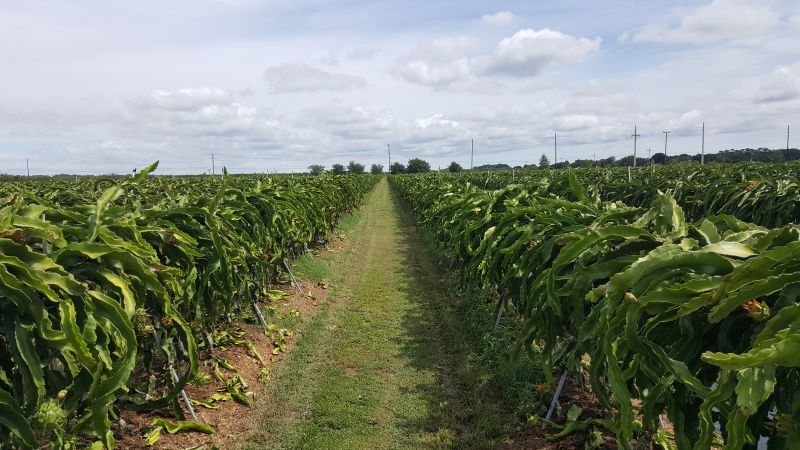Citrus greening is making citrus production very challenging and expensive. Many growers in Florida are looking for high value alternative crop with same or even higher profit compare to citrus. One tropical fruit native to Mexico and Central and South America has gained attention recently. Pitaya (genus Hylocereus, also known as dragon fruit), is a climbing-vine cactus species. Nowadays pitaya is a very popular fruit in the United States and its unique taste, appearance and health benefits (rich in the antioxidant) increased its popularity at high-end restaurants. Pitaya can be eaten freshly or processed into juice, desserts, jam, ice cream, cocktails and wine.
Today I visited a pitaya farm in Vero Beach, FL, that is owned by a Chinese family. Unfortunately, the man that was in charge of the farm was not able to speak English, so I came back with just some great pictures of the farm. I also found that they ship all fruits to New York where they will be sold. If you are interested in pitaya (dragon fruit), you can find a great information about pitaya production in this link.
Why some dragon fruit plants do not set fruit?
I am asked this question several times so I think many people faced this problem. The flowers of dragon fruit are hermaphroditic, meaning plant has male and female reproductive organs within the same flower. However, some dragon fruit species and cultivars are self-incompatible. Self-incompatibility has been observed in several cultivars and it is highly recommended to plant two to three different genetic types (not the same clone or variety) to increase fruit production. So cross-pollination between different types guaranties a better yield. Flowers are open at night so moth and bats act as pollinators. Alternatively, hand-pollination at night or early morning will help to see a better result.
Can we grow dragon fruit in Florida?
Dragon fruit grows best in the area with no frost or freeze but they easily tolerate cool or warm climates. Although they are considered a full-sunlight crop in their native area, but they can be injured by direct sunlight. Therefore, 30% shade is recommended during the first 3 to 4 months after planting. The optimum temperature for growing dragon fruit is 65°F–77°F.
How to propagate dragon fruits?
Vegetative propagation is preferred by using stem cuttings. Stem cutting segments of 6-15 inches are used as cuttings. It is recommended to used fungicide on the base of cutting and leave it to cure and dry for 7-8 days before planting. Cuttings grow very fast and produce the first fruits 6-9 months after planting. Mature plants (3 to 4 years old) may produce about 220 lb of fruit per year.
 1
1


